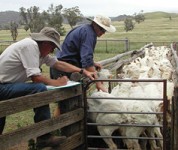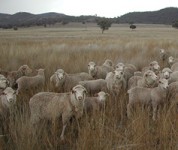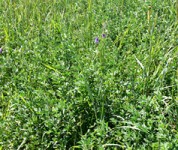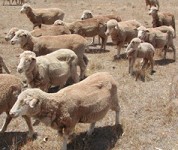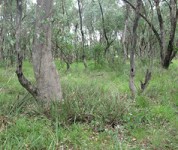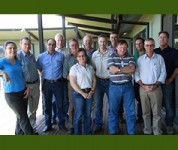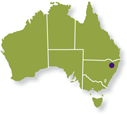Key Results
Click on the key result heading to see full information.
On-farm monitoring of livestock and pastures
- On-farm monitoring showed all native perennial grass pastures had available green herbage mass levels below the minimum level in the critical June to September period for spring lambing ewes.
- Weaning percentage increased from ~70 to >110%, where forage oats and/or lucerne were included in the feedbase.
- Raising ewe fat score to meet target fat score at joining resulted in higher weaning percentage.
- Pasture herbage mass was easily and accurately assessed by estimating pasture height and density.
- A simple spreadsheet-based feed calculator that utilised the livestock months (LSM) concept enabled changes in pasture types/areas and sheep numbers to be rapidly computed, providing a visual output of the likely match between feed supply and animal requirements for a whole farm.
Lucerne-grass mixtures
- Lucerne established and persisted (over three years) when grown with tropical grass (digit grass).
- Herbage production of digit grass was similar irrespective of the lucerne sowing rate, indicating that total production increased with lucerne sowing rate (0.5 to 2.0 kg/ha).
- Row configuration (either alternate 1:1 or 1:2 rows) did not affect either herbage production or persistence.
- Sowing lucerne in spring resulted in poor establishment, and sowing digit grass in autumn resulted in low plant density.
- When species in a mixture were sown in split sowings at different times, lucerne dominated autumn sowings and digit grass dominated spring sowings.
- A lucerne-grass mixture grew similar herbage mass to pure lucerne over three years and more than grasses alone.
- Herbage mass of digit grass was similar in mixture with lucerne irrespective of the lucerne sowing rates tested.
- Two different lucerne-grass mixtures developed patterns of soil water extraction over time that were similar to pure lucerne alone.
- Two lucerne-grass mixtures had higher ground cover throughout the year compared to lucerne alone, which did not meet the benchmark minimum of 70% ground cover most of the time.
- Two lucerne-grass mixtures substantially reduced runoff rate and eroded sediment compared to lucerne alone. A mixture with tropical grass offered greater protection than did a mixture with temperate grass.
On-farm conservation
- Studies conducted on-farm showed that parts of the farm that are not grazed by livestock are important for creating habitat variety, and are best targeted for protection, restoration and regeneration.
- Woodland vegetation that was not grazed by livestock made a large contribution to regional plant diversity, despite its very limited extent in the landscape.
- Native pastures regenerating after cultivation re-established total species densities comparable with those of uncultivated native pastures 10–25 years after the last cultivation, and comparable native species densities 15–30 years after the last cultivation.
- Data collected on-farm showed that the composition of grazed native pastures was quite uniform, with species comprised of a limited suite of grazing-tolerant, native and exotic grasses and forbs.
- Our data also suggest that the relationship between livestock grazing and plant conservation is antagonistic.
Publications
Webpage
Manage climate variability in northern NSW
Overview Climate variability represents a constant challenge to effectively managing a grazing enterprise. The climate of Northern NSW is more variabl…
Read MoreMurphy, S. McCormick, L; 2014; EverGraze
Webpage
Modelling to develop recommendations for managing variability
Pasture utilisation is widely regarded as a key driver of profitability for the red meat and wool industries in southern Australia (Lodge et al. 2012)…
Read MoreSean Murphy, Lester McCormick; 2014; EverGraze, Future Farm Industries CRC
Webpage
Tamworth Proof Site climate
Northern NSW has a variable climate compared with most other parts of Australia, receiving weather systems from both northern and southern influences….
Read MoreSean Murphy; 2014; EverGraze, Future Farm Industries CRC
Webpage
Tamworth lucerne-grass mix hydrology and production experiments
Lucerne is the most widely sown and adapted perennial legume on the Northern Slopes of NSW, but has fallen from favour in recent years. One reason for…
Read MoreSean Murphy, Lester McCormick, Suzanne Boschma; 2014; EverGraze, Future Farm Industries CRC
Webpage
Conservation of Box Gum Grassy Woodlands on the North West Slopes of NSW is best achieved through on-farm management of high quality remnant patches.
Native vegetation on farms, particularly woodlands and little disturbed grasslands on gently sloping country, can be important for biodiversity conser…
Read MoreSean Murphy, Lester McCormick; 2014; EverGraze, Future Farm Industries CRC
Webpage
On-farm monitoring of livestock and pastures
Many producers on the North West Slopes of NSW are seeking answers about how to best manage their native grass based pastures and how to integrate the…
Read MoreSean Murphy, Lester McCormick; 2014; EverGraze, Future Farm Industries CRC
Webpage
Conservation of Box–Gum grassy woodlands on the North West Slopes of NSW
The wheat–sheep belt of NSW is a productive agricultural region. However, it is also a region in which native vegetation has been fragmented, degraded…
Read MoreSean Murphy, Lester McCormick; 2014; EverGraze, Future Farm Industries CRC
Report
EverGraze Impact Report – June 2011 to June 2012
The purpose of this report is to summarise the Impact of the EverGraze project based on evaluation data collected from activities between July 2011 an…
Read MoreEverGraze; 2012; EverGraze
Select
Native pastures Directions Paper
Following a brief historical overview of the development of native pastures, a description of their current state is presented. This will, by necessit…
Read MoreJim Virgona; 2006; EverGraze, Future Farm Industries CRC
Webpage
North West Slopes NSW – Environmental Issues
The Northern NSW EverGraze region supports a diversity of landscapes, ranging from the Liverpool, Warrumbungle and Kaputar Ranges, through the rolling…
Read MoreSean Murphy, Lester McCormick; 2014; EverGraze, Future Farm Industries CRC

